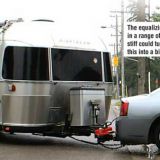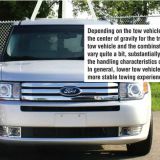
During most of the decades that people have towed Airstreams, the load capacity of the tow vehicle has not been a concern. In the 1960s and 1970s particularly, owners towed Airstreams millions of miles with sedans from that era. Those cars had huge trunks and they were often filled to the brim since the trailers had virtually no exterior storage.
The result was vehicles that were likely over their rated load capacity by quite a bit, but it’s hard to point to widespread problems that resulted from this. Few seemed to worry about it, perhaps thinking that 150 to 200 pounds of extra load per tire would never be enough to break anything.
Would you ever consider carrying more than the rated weight capacity on a vehicle? You might quickly think, “Never!” but it’s likely you have quite regularly. Solo SUVs, vans or cars loaded for family vacation are often well over their weight rating, as are millions of commercial pick-ups and vans. Most people never realize this because they don’t weigh their cargo (and passengers) before every trip, but fortunately these excesses don’t usually cause problems. My point is only that load capacity is not something to totally ignore or exceed by a wild margin, but I wouldn’t exaggerate its importance.
There are two acronyms related to a vehicles load capacity:
GVWR means “Gross Vehicle Weight Rating.” In theory, this is the maximum weight a vehicle can be when fully loaded.
GAWR stands for “Gross Axle Weight Rating.” In theory this is the maximum load an axle can carry. Sometimes you will see RGAWR or FGAWR for “Rear Gross Axle Weight Rating” or “Front Gross Axle Weight Rating.” Axle ratings may be limited by tire capacity, the axle capability, or because the automaker is concerned about vehicle dynamics when a certain weight is exceeded.
If you have been reading this column for a while you will be aware that I have some issues with the Society of Automotive Engineers (SAE) standard for hitches as well as some of the methods and motivations used to develop tow ratings. Because they have very little time to pay attention to it, it seems few auto engineers really have any in-depth understanding of trailer towing. What little testing they do perform is with improperly connected weight distribution on receivers that are too weak to perform properly, largely on a test track and without much real-world experience.
Often a lighter vehicle with independent suspension (like this Porsche Cayenne) can tow better overall than a heavier truck, even when it’s close to the manufacturer’s maximum weight rating.
However, I will say I think most of the engineering in modern vehicles is nothing short of amazing in areas where engineers are allowed to devote a lot of attention and the marketing or legal department does not get to trump their decisions. Most vehicles are over-engineered, especially in regard to the chassis and running gear.
The inconsistencies of manufacturers weight ratings begin to show when you look at them closely. For example, on many vehicles the front and rear axle ratings added together total more than the GVWR. Currently you can purchase a ¾ ton 4x4 diesel crew cab with a dry weight of 7,429 pounds. The front axle rating is 5,500 pounds and the rear is 6,010. This means that if you could distribute the weight perfectly the truck should be able to carry 11,520 pounds – but the GVWR is only 9,600.
So according to the GVWR, that big heavy-duty truck can carry just 2,170 pounds. Why is it de-rated so much? We can theorize that when the truck is driven solo with more than 2,170 pounds of load it becomes more unstable than the manufacturer is comfortable with. But this theory doesn’t hold up when we look at the shorter wheelbase regular cab version. It should tend to be less stable, yet it has more payload (2,500 pounds). Conversely the same truck with two-wheel drive has even less payload, despite this version being lower to the ground and having independent front suspension instead of a live axle (which means it handles considerably better). It seems that many of these ratings are generated by methods that aren’t solely engineering-based. I believe there’s some “It’s how we have always done it” involved.
Often, we will see two vehicles with identical suspension components, tires, transmission, etc., but with different axle weight (GAWR) ratings. For example, this might be seen in short and long versions of the same SUV. This is helpful, because when we are setting up a very high hitch weight trailer, we will often use the short version of an SUV that we know had a higher rated capacity in its longer version. The shorter version allows us to transfer the hitch weight more easily, while knowing that we are not overloading any suspension components. Again, I don’t want to imply that you can completely ignore weight ratings. I would not want to see an axle 1,000 pounds over its rating, and you never want tires over their rating.
Sometimes we will make changes to the Airstream itself to reduce tongue weight. When Airstream was making units with slide-outs, which had very high tongue weights, we ordered them without the front battery compartments and would move the batteries to a location under the bed. Since a double-axle Airstream does not really need a spare (you can tow on three wheels if necessary) we also eliminated the spare tire and carrier. These are pretty simple changes to make if needed.
Let’s look at some real-world weights and ratings. One of my favourite tow vehicles is the Chrysler 300. The towing weights listed here are my actual 300 connected to an Airstream 34-foot Classic loaded for vacation with four people in the car. In the truck were two sets of golf clubs and a few miscellaneous items. For comparison, I also weighed the car solo (without the trailer), when driving to a meeting with four people in it and suitcases in the trunk.
When towing with this car we are 310 pounds over the GVWR and 70 pounds over the rear axle rating, and well below the tire ratings. But note that the rear axle is 100 pounds more overloaded on the solo trip (170 pounds versus 70), and also note that the car is considerably less balanced than it is when towing. This underscores how easy and commonplace it is to overload vehicles with just ordinary passengers and cargo, and how passenger/cargo loading tends to put more weight on the rear axle than a trailer with proper weight distribution.
Let’s say that the 70 pounds excess weight on the rear axle really concerns me, so I go instead to a truck-based SUV. The Ford Expedition is the one I would recommend. It has a very robust 4-wheel independent suspension and with the right tires, in my opinion, it is the best handling truck-based tow vehicle.
Here is the same table with a customer’s Ford Expedition and an Airstream 30-foot International loaded for travel with a family of four and about 300 pounds of stuff in the rear cargo area.
Certainly the Expedition had considerably more interior space than the Chrysler 300 and is a better off-road vehicle, but if weight ratings or safety are your primary reason for buying an Expedition instead of a Chrysler 300, then not much has been accomplished. The Expedition is still 249 pounds over the GVWR and 30 pounds over the rear axle rating.
Also, with the Expedition you will be driving a vehicle all year long that weighs 1,400 pounds more, has a much higher centre of gravity, and yet still has the same size brakes. Although very stable for a large SUV, the Expedition still does not come close to the Chrysler 300 for stopping distance or accident-avoidance agility, and it has a much higher chance of rolling over.
On either the Ford Expedition of the Chrysler 300 it would be possible to bring the axle weights under the rating with a little adjustment of loading and torsion bars. However, let’s say that I am still concerned about being near the weight rating, and so I decide to get a ¾ ton truck.
The next chart is for a Dodge 2500 4x4 crew cab with the same trailer as above, and with similar loading and the addition of a fiberglass box cover and a bed liner. Due to the length of the truck, it is harder to transfer weight to the front wheels. On the other hand, Cummins diesel engine ensures there will still be plenty of weight on the front wheels.
If your focus is weight capacities, you can take a big sigh of relief because everything looks good. This combination is 160 pounds below the GVWR and has around 1,000 pounds of capacity on each axle.
I would just ask that you think about what you are giving up to get this comfort level with some numbers on paper. You are now driving a vehicle with a very high centre of gravity that weighs 3,000 pounds more than the Chrysler 300 and 1,600 pounds more than the Ford Expedition.
The chart above tells the story. The Dodge 2500 has a longer wheelbase and shorter overhang than the Chrysler 300, which is good for stability, (see my discussion about wheelbase and overhand in Airstream Life, Fall 2012) but in all other respects compares unfavourably.
The high centre of gravity on the Dodge 2500 is aggravated by a much narrower suspension stance (42” compared to 63.6” on the Chrysler 300). Also, most of the time the springs are far too stiff for the job they have to do. Combined with massive un-sprung wight on the front and rear axles, this means that emergency handling on anything but smooth pavement is not great. Likewise, accident-avoidance capability is pretty dismal compared with the Chrysler 300 and a long way even from the Ford Expedition.
Most people don’t notice this because they don’t deliberately push their truck to test emergency handling performance. Just driving down the road they feel very good. But I get a letter once or twice a year from a customer telling me how the stability of their rig kept them out of an accident, so I know it is a factor at times.
On the Dodge 2500, the E-range LT tires are durable but lacking in bite, and even though the brakes are slightly larger they are not proportional to the weight increase, so stopping distances are longer than the Chrysler 300 or Ford Expedition. Even if you have to stop the trailer without brakes, the Chrysler 300 will stop sooner than the truck! You might wonder how that’s possible, but keep in mind that the Chrysler has 3,000 pounds less mass to stop, with almost the same brakes and much stickier tires.
The Chrysler 300 pictured below with a new 30-foot Airstream at Cape Hatteras features a 306 horsepower 3.6 litre V6 engine mated to an eight-speed ZF transmission. Besides being stable and comfortable, it turns in a zero to sixty times of 21 seconds while towing and still delivers 35 MPG highway as a solo vehicle.
Some people feel having a heavy truck puts them in a better position with regards to liability should they be involved in an accident. I have never been able to get my head around this kind of logic, since the most likely vehicle to get into an accident whether towing or solo is the ¾ ton truck. If you do hit another vehicle, you are far more likely to injure those in the other car, so to my way of thinking the ¾ ton truck is the riskiest vehicle to drive.
Now in fairness there are other factors here. As a Solo vehicle I know I drive a Chrysler 300 faster and more aggressively thank I would ever dream of driving a ¾ ton pickup. On the other hand, there are also studies that say that people driving tall large vehicles tend to feel invincible and take risks they would not take in a smaller car. It’s hard to say how these factors balance in the real world, but the good news is that accidents are very rare.
Another factor I notice as an Airstream dealer is that people who tow with ½ tons and lighter vehicles are usually pretty aware of their hitch set-up. They are more likely to get it right. On a ¾ ton they are more likely to ignore the torsion bar settings etc., possibly because they feel they don’t have to be concerned. If you have a heavy truck, don’t make the mistake of thinking you are invincible. Proper hitching is still important.
Like everything else to do with towing, there is no one absolute number to look at in your towing equation. Try to assess all the factors that go into a combination and then choose the one that suits your lifestyle. If the other properties of the tow vehicle are fantastic and the only thing concerning you is that you are near the rated axle or overall vehicle weight rating, I would recommend the tow vehicle that is right for you.
Originally Published in Airstream Life | Winter 2013










